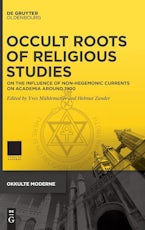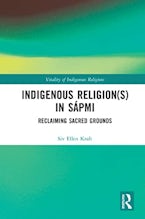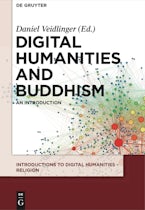- Home
- Okkulte Moderne
- religion
- body, mind & spirit
- education
- Occult Roots of Religious Studies

Occult Roots of Religious Studies
On the Influence of Non-Hegemonic Currents on Academia around 1900
Edited by: Yves Mühlematter and Helmut Zander
Series: Okkulte Moderne
295 Pages
- eBook
- ISBN: 9783110660173
- Published By: Walter de Gruyter GmbH
- Published: June 2021
$63.99
The first and primary thesis of Occult Roots of Religious Studies: On the Influence of Non-Hegemonic Currents on Academia around 1900 is that religious studies have little-known and sometimes repressed origins which lie in the field of esotericism. The second thesis, which stems directly from this idea, holds that esotericism is an intrinsic part of hegemonic cultures and not a separate, small, “secret”, or “occult” field of minority religions” (1). In the introduction, editors Yves Mühlematter and Helmut Zander summarize important themes in the book. One is concealment. Religion scholars in the latter half of the 19th century wrote about the evolution of religious studies as an increasingly scientific undertaking, first in philology and ethnology, and later in the social sciences. The rising dominance of modern, orthodox science in the study of religion hid the occult roots of that study.
Another theme is that religion scholars of the 19th century went in certain directions with their research because of their links to occult groups. The most important of these groups was Theosophy, with others making important contributions. These include anthroposophy in Sabine Böhme’s chapter, magnetism and spiritualism in Daniel Cyranka’s chapter, and Kabbalah in Boaz Huss’ chapter. In many cases, the influence of occult groups led to divisions between occult and scientific approaches to religion, as was the case with study of Tantra in Julian Strube’s chapter, the study of Kaballah in Huss’ chapter, and British interpretations of religion and the occult in Marco Frenschkowski’s chapter.
Another major theme is the concern with science and religion’s roles in religious studies. Was the study of religion a dispassionate assessment of available evidence, or was it a celebration of emic views? The latter option was often affirmed by those who believed that before the foundation of historic religious traditions, a universal religion or spiritual force existed. Theosophy championed this assertion, but so did early scholars of religion: Andrew Lang and John Woodroffe in Great Britain, Paul Masson-Oursel in France, and Walter Andrae in Germany. Closely linked to this theme was a third: the comparative study of religions. Throughout the 19th century, scholars whom we would today regard as scientific were investing more and more time and effort in comparing religions of the world. They did so to arrive at meaningful models of religious life and thought. Scholars deeply influenced by occultism were more likely to make comparisons among religions to justify occult views, which included the universality of a primordial religion.
A fourth major theme was the blurred line separating science from occultism among religion scholars. In spite of these divisions, however, the methods of both contingents were similar. “Theosophists claimed to work empirically” (5), according to the editors. “Occult science” was a widely accepted phrase until well into the 20th century. But the more orthodox scientists (non- or anti-occult) eventually won the conflict, largely as a result of their location in emerging, modern universities in Europe (and the United States and Commonwealth countries, I might add). Scholars working in social science disciplines, and those in humanities as well, received research support and validation as serious students of religious studies. These scholars were the hegemony referred to in this book’s subtitle. The “non-hegemonic currents” were those sympathetic to occult influences who eventually were pushed out of formal (hegemonic) academic circles.
The editors and contributors depend on biography to show the blurring of boundaries between occult and scientific viewpoints. The editors admit that initially they underestimated the importance of biography, but eventually accepted it as a method to uncover occult/scientific conflicts and cooperation. All of the chapters except the introduction and Zander’s contribution focus on one or more key figures. The latter include some names known to scholars today, like John Woodroffe, Friedrich Max Müller, Walter Y. Evans-Wentz, Gershom Scholem, and Walter Andrae. Other scholars of less renown also find a place in this book, particularly Nees von Esenbeck and Paul Masson-Oursel. Some were committed to the scientific method, while others mixed their interests in occult traditions with their scholarly work on religion. In addition to those scholars highlighted in the book’s chapters, the editors also appended fourteen short biographies of influential scholars in the history of religious studies. As with those discussed in separate chapters, so here, the list includes both well-known and relatively unknown people. Daisetsu Teitarō Suzuki and Ananda Kentish Coomaraswamy, for example, are familiar to religious studies scholars, but that’s not the case with others in the list.
Why this emphasis on biography? In my view, several answers to this question spring to mind. One reason is the limitations of available evidence. The primary materials that historians work with are correspondence, diaries and journals, and manuscripts. These types of evidence ideally reveal the inner lives of people for whom writing and reading are essential to their vocations. Through reliance on such evidence, the historian can reconstruct, albeit imperfectly, the motivations that historic agents felt and exercised, and through these insights, historians may then be able to build larger arguments about the directions that scholars in a field or discipline take.
Another reason for the emphasis on biography is that the phenomena explored in this book would not be observable through other forms of evidence, such as conference proceedings, edited volumes, symposia, and the like. Only at the level of the individual, or several individuals, can we discern the rising tide of science and the ebb of occultism, or rather, the relegation of the latter to the margins. Finally, it’s fun and enriching to read about people’s lives. Many readers like to know how biographical subjects dealt with the ups and downs in their lives. We feel a kinship with them or are thankful that our lives aren’t as bad as theirs, or we admire them for their accomplishments. Whatever a reader’s motivation, biography brings us into direct, even intimate, contact with a subject’s feelings, thoughts, and contexts.
This is a fine, and timely collection. The contributors add immensely to our understanding of the tensions among European scholars who pioneered in religious studies.
W. Michael Ashcraft is professor of religion at Truman State University.
W. Michael AshcraftDate Of Review:August 30, 2022
Yves Mühlematter, University of Fribourg, Freiburg, Switzerland
Helmut Zander, University of Fribourg, Freiburg, Switzerland











